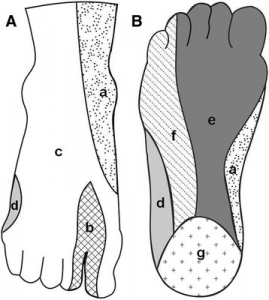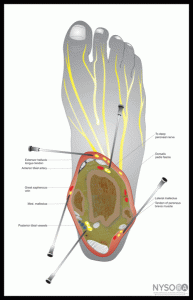Imagine your patient is minding his or her own business when their foot gets crushed by a bus. This totally hypothetical occurrence is only one of an infinite number of examples of situations that could result in a complex wound(s) needing repair.
For wounds on the soles of the feet, adequate anesthesia via local infiltration is notoriously difficult. But, in order to get good wound exploration, proper irrigation, and closure, pain control is essential. If the wound involves more of the foot than just a toe, a simple ring block may not be an option. Consider doing your patient a solid and give them an ankle block. Trust me, they will love you….hypothetically.
Depending on the location of the injury, you will need to target one (or more) of five nerves. [Remember that lidocaine is shorter acting (10-40 minutes) and bupivacaine is longer acting (2-9 hours).] This pearl covers the landmarks and locations of the nerves themselves, but for more information on nerve blocks in general, see the references below.
Figure: Cutaneous innervation of the foot. a Dorsal surface b Plantar surface
a) Saphenous nerve b) Deep peroneal nerve c) Superficial peroneal nerve d) Sural nerve e) Medial plantar nerve (branch of tibial nerve) f) Lateral plantar nerve (branch of tibial nerve) g) Medial calcaneal nerve (branch of tibial nerve)
HOW TO PERFORM EACH NERVE BLOCK (taken from the Mayo Clinic website, see link below):
Saphenous Nerve Block (medial foot)
- Inject 2-5-mL of anesthetic subcutaneously between the medial malleolus and the anterior tibial tendon.
Deep Peroneal Nerve Block (between the 1st and 2nd toes)
- Have the patient dorsiflex their foot and insert the needle 1-cm above the medial malleolus aiming underneath the extensor hallucis longus tendon and advance until you hit the tibia. Then inject 3-5-mL of anesthetic.
Superficial Peroneal Nerve Block (dorsal aspect of foot and toes)
- Inject 4-10-mL of anesthetic subcutaneously in a band between the lateral malleolus and the extensor hallucis longus tendon.
Sural Nerve Block (Posterior and lateral foot)
- Inject 3-5-mL of anesthetic subcutaneously in a band between the Achilles tendon and 1-cm above lateral malleolus.
Posterior Tibial (medial plantar and lateral plantar) Nerve Block (sole of the foot)
- Palpate the posterior tibial artery behind the medial malleolus. Inject 3-5-mL of anesthetic 1-cm in depth 1-cm superior to this point.
BONUS: For those of you who like to sew, this website contains excellent tutorials for wound closure, ring blocks and more related topics. Google search “Closing the gap” or check it out here:
References:
https://emblog.mayo.edu/2014/07/14/5-simple-steps-in-the-ankle-block/
Roberts, J. R. (2004). Nerve Blocks of the Thorax and Extremities. Clinical procedures in emergency medicine (4th ed.). Philadelphia, PA: W.B. Saunders.
Image from:
Primadi A, Xu HX, Yoon TR, Ryu JH, Lee KB. Neurologic injuries after primary total ankle arthroplasty: prevalence and effect on outcomes. J Foot Ankle Res. 2015;8:55. Published 2015 Oct 2. doi:10.1186/s13047-015-0112-7


